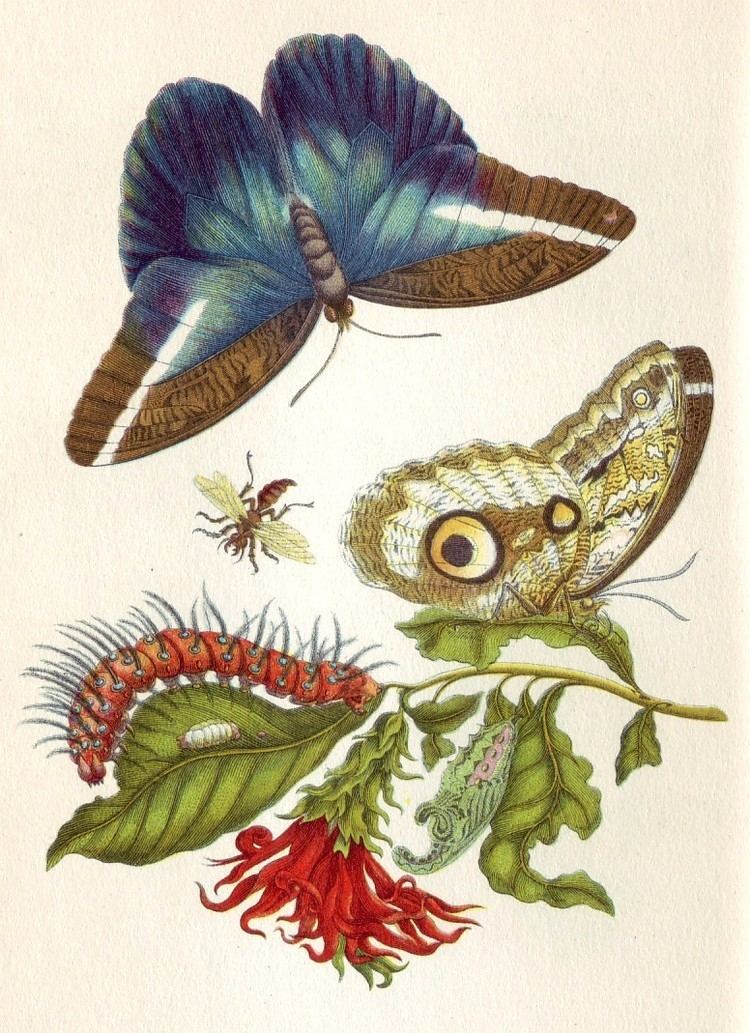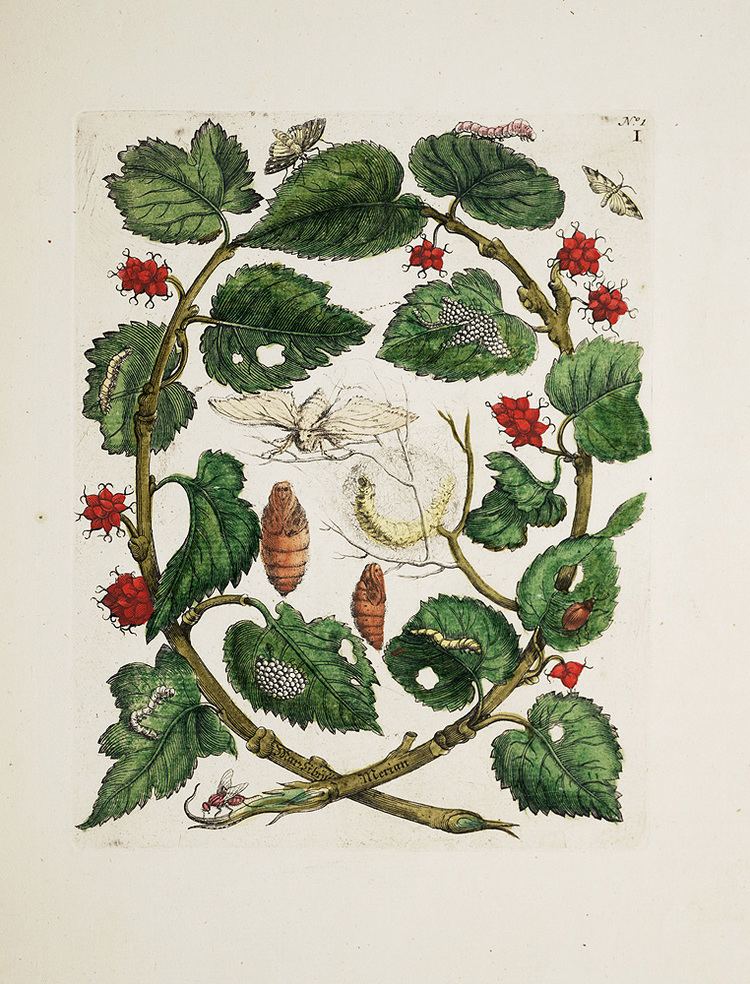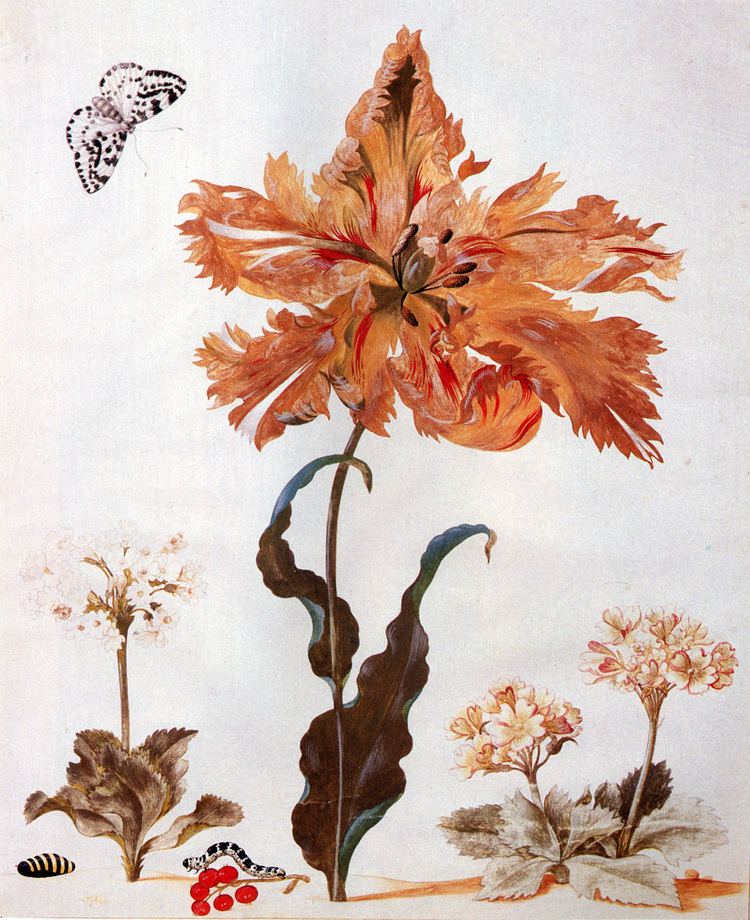Name Maria Merian | Role Naturalist | |
 | ||
Spouse Johann Andreas Graff (m. 1665–1692) Artwork Red-billed toucan, Golden tegu lizard Children Johanna Helena Herolt, Dorothea Maria Graff Books Metamorphosis insectorum Surinamensium, New Book of Flowers, Flowers - Butterflies and Insec, Merian's Antique Botanical, Flowers Similar People Matthaus Merian, Jacob Marrel, Georg Gsell, Natalie Zemon Davis | ||
Maria sibylla merian google doodle
Maria Sibylla Merian (2 April 1647 – 13 January 1717) was a German-born naturalist and scientific illustrator, a descendant of the Frankfurt branch of the Swiss Merian family, founders of one of Europe's largest publishing houses in the 17th century.
Contents
- Maria sibylla merian google doodle
- Maria sibylla merian
- Early life and early career
- Friesland
- Amsterdam
- Suriname
- Modern appreciation
- Work
- Eponyms
- Popular culture
- References

Merian received her artistic training from her stepfather, Jacob Marrel, a student of the still life painter Georg Flegel. She remained in Frankfurt until 1670, relocating subsequently to Nuremberg, the small village of Wieuwerd in the Dutch Republic (1685), where she stayed in a Labadist community till 1691, and Amsterdam.

Merian published her first book of natural illustrations, titled Neues Blumenbuch, in 1675 at age 28. In 1699, following eight years of painting and studying, and on the encouragement of Cornelis van Aerssen van Sommelsdijck, the then-governor of the Dutch colony of Surinam, the city of Amsterdam awarded Merian a grant to travel to South America with her daughter Dorothea. Her trip, designed as a scientific expedition makes Merian perhaps the first person to "plan a journey rooted solely in science." After two years there, malaria forced her to return to Europe. She then proceeded to publish her major work, Metamorphosis insectorum Surinamensium, in 1705, for which she became famous. Because of her careful observations and documentation of the metamorphosis of the butterfly, she is considered by David Attenborough to be among the most significant contributors to the field of entomology. She was a leading entomologist of her time and she discovered many new facts about insect life through her studies.

Maria sibylla merian
Early life and early career

Maria Sibylla Merian's father, the Swiss engraver and publisher Matthäus Merian the Elder, married her mother, his second wife, Johanna Sybilla Heyne, in 1646. Maria was born within the next year in 1647, making her his 9th child. Her father died in 1650, and in 1651 her mother remarried the flower and still life painter Jacob Marrel. Marrel encouraged Merian to draw and paint. While he lived mostly in Holland, his pupil Abraham Mignon trained her. At the age of thirteen she painted her first images of insects and plants from specimens she had captured. Early on, she had access to many books about natural history. Regarding her youth, in the foreword to Metamorphosis insectorum Surinamensium, Merian wrote: "I spent my time investigating insects. At the beginning, I started with silk worms in my home town of Frankfurt. I realized that other caterpillars produced beautiful butterflies or moths, and that silkworms did the same. This led me to collect all the caterpillars I could find in order to see how they changed".

In May 1665, Merian married Marrel's apprentice, Johann Andreas Graff from Nuremberg; his father was a poet and director of the local high school, one of the leading schools in 17th-century Germany. In January 1668, she had her first child, Johanna Helena, and the family moved to Nuremberg in 1670, her husband's home town. While living there, Merian continued painting, working on parchment and linen, and creating designs for embroidery. She also gave drawing lessons to unmarried daughters of wealthy families (her "Jungferncompaney", i.e. virgin group), which helped her family financially and increased its social standing. This provided her with access to the finest gardens, maintained by the wealthy and elite, where she could continue collecting and documenting insects. In 1678, she gave birth to her second daughter Dorothea Maria. In 1679, she had published her first work on insects which was a two-volume, illustrated book focusing on insect metamorphosis.
In 1678, the family had moved to Frankfurt am Main, but her marriage was an unhappy one. She moved in with her mother, after her stepfather died in 1681. In 1683 she traveled to Gottorp and was attracted to the Labadists community in Holstein. In 1685 Maria traveled with her mother, husband and children to Friesland where her half-brother Caspar Merian had lived since 1677.
Friesland
After Jean de Labadie had died, Pierre Yvon moved the community to a stately home – Walt(h)a Castle – at Wieuwerd in Friesland, which belonged to three sisters Van Aerssen van Sommelsdijck, who were his adherents. Here, printing and many other occupations continued, including farming and milling.
At its peak, the religious community numbered around 600 with many more adherents further afield. Visitors came from England, Italy, Poland and elsewhere, but not all approved of the strict discipline, separatism and community property. Those of arrogant disposition were given the most menial of jobs. Fussiness in matters of food was overcome since all were expected to eat what was put in front of them. It seems the community had problems with Merian's husband; he was refused but came back twice.
Several noted visitors have left their accounts of visits to the Labadist community. One was Sophie of Hanover, mother of King George I of Great Britain; another was William Penn, the Quaker pioneer, who gave his name to the US state of Pennsylvania; a third was the English philosopher John Locke. In 1690 her mother died.
Amsterdam
In 1691, she moved with her daughters to Amsterdam and met with Agnes Block, Caspar Commelin, Michiel van Musscher and Steven Blankaart. In 1692, her husband divorced from her. In Amsterdam the same year, her daughter Johanna married Jakob Hendrik Herolt, a successful merchant on Surinam, originally from Bacharach. The flower painter Rachel Ruysch became her pupil.
In 1699, the city of Amsterdam granted Merian permission to travel to Suriname in South America, along with her younger daughter Dorothea Maria. On 10 July their ship set sail. The goal of the mission was to spend five years illustrating new species of insects. In order to finance the mission, she sold 255 of her own paintings. Before departing, she wrote:
In Holland, with much astonishment what beautiful animals came from the East and West Indies. I was blessed with having been able to look at both the expensive collection of Doctor Nicolaas Witsen, mayor of Amsterdam and director of the East Indies society, and that of Mr. Jonas Witsen, secretary of Amsterdam. Moreover, I also saw the collections of Mr. Fredericus Ruysch, doctor of medicine and professor of anatomy and botany, Mr. Livinus Vincent, and many other people. In these collections I had found innumerable other insects, but finally if here their origin and their reproduction is unknown, it begs the question[sic] as to how they transform, starting from caterpillars and chrysalises and so on. All this has, at the same time, led me to undertake a long dreamed of journey to Suriname.
Suriname
Merian arrived on 18/19 September in Surinam, and met with the governor Paulus van der Veen. She worked for two years, traveling around the colony and sketching local animals and plants. She criticized Dutch planters' treatment of natives and black slaves. She recorded local native names for the plants and described local uses. In June 1701, malaria forced her to return to the Dutch Republic.
Despite her criticism of planters' treatment of slaves, Merian herself owned slaves. Ship lists indicate that she was master to an "Indian woman" who helped to collect specimens while in Suriname. It is speculated that Merian actually owned two "Indian" slaves, but only one returned to Amsterdam with her.
Back in the Netherlands, Merian lived in Kerkstraat, where she opened a shop. Merian sold specimens she had collected and published a collection of engravings of plant and animal life in Suriname. In 1705, she published a book Metamorphosis Insectorum Surinamensium about the insects of Suriname.
In 1715, Merian suffered a stroke and was partially paralysed. She continued her work, but her illness probably affected her ability to work. A later registry lists her as a pauper.
Maria Sibylla Merian died in Amsterdam on 13 January 1717 and was buried four days later. Her daughter Dorothea published Erucarum Ortus Alimentum et Paradoxa Metamorphosis, a collection of her mother's work, posthumously.
Modern appreciation
In the last quarter of the 20th century, the work of Merian was re-evaluated, validated, and reprinted. Her portrait was printed on the 500 DM note before Germany converted to the euro. Her portrait has also appeared on a 0.40 DM stamp, released on 17 September 1987, and many schools are named after her. In the late 1980s Archiv imprint of the Polydor label issued a series of new recordings of the piano works of Wolfgang Amadeus Mozart performed on period instruments by Malcolm Bilson (fortepiano), with the English Baroque Soloists conducted by John Eliot Gardiner; the original cover design of each of the individual discs in the series, and the original boxed set of the complete piano concertos (as well as a disc of Mozart piano quartets) all featured Merian's floral illustrations. In 2005, a modern research vessel named Maria S. Merian was launched at Warnemünde, Germany. She was honored with a Google Doodle on 2 April 2013 to mark her 366th birth anniversary.
In 2016, Merian's Metamorphosis insectorum Surinamensium was re-published with updated scientific descriptions and, in June 2017, a symposium will be held in her honor in Amsterdam.
Work
Merian worked as a botanical artist. She published collections of engravings of plants in 1675, 1677, and 1680. She collected and observed live insects and created detailed drawings to illustrate insect metamorphosis. In her time, it was very unusual that someone would be genuinely interested in insects, which had a bad reputation and were considered "vile and disgusting." As a consequence of their reputation, the metamorphosis of these animals was largely unknown. Merian described the life cycles of 186 insect species, amassing evidence that contradicted the contemporary notion that insects were "born of mud" by spontaneous generation. Moreover, although certain scholars were aware of the process of metamorphosis from the caterpillar to the butterfly, the majority of people did not understand the process.
Merian's process of creating her art used vellum charta non nata which she primed with a white coat. Because of the guild system in Europe, women were not allowed to paint in oil. Merian painted with watercolors and gouache, instead.
The work that Maria Sibylla Merian published, Der Raupen wunderbare Verwandlung und sonderbare Blumennahrung – The Caterpillars' Marvelous Transformation and Strange Floral Food, was very popular in certain segments of high society as a result of being published in the vernacular. However, her work was largely ignored by scientists of the time because the official language of science was still Latin.
Merian also described many other details of the evolution and life cycle of the insects she observed. For example, she showed that each stage of the change from caterpillar to butterfly depended on a small number of plants for its nourishment. She noted that as a consequence, the eggs were laid near these plants.
Merian was one of the first naturalists to observe insects directly. This approach gave her much more insight into their lives and was contrary to the way that most scientists worked at the time. Today, while Merian has experienced reinvigorated fame in the eyes of the art and science communities, much of her work has finally been accurately reattributed to her daughters, Dorothea and Johanna. Joanna Helena Herolt often did not receive credit for her artwork because they were created in collaboration with her mother. Today her works are in the process of recovery. Similarly, Dorothea Maria Graff's images have only recently been accredited to the German painter: Sam Segal has reattributed 30 or 91 folios in the British Museum.
The pursuit of her work in Suriname was an unusual endeavor, especially for a woman. In general, only men received royal or government funding to travel in the colonies to find new species of plants and animals, make collections and work there, or settle. Scientific expeditions at this period of time were not common, and Merian's unofficial, self-funded expedition raised many eyebrows. She succeeded, however, in discovering a whole range of previously unknown animals and plants in the interior of Surinam. Merian spent time studying and classifying her findings and described them in great detail. She not only described the insects she found, but also noted their habitat, habits and uses to indigenous people. Her classification of butterflies and moths is still relevant today. She used Native American names to refer to the plants, which became used in Europe:
I created the first classification for all the insects which had chrysalises, the daytime butterflies and the nighttime moths. The second classification is that of the maggots, worms, flies, and bees. I retained the indigenous names of the plants, because they were still in use in America by both the locals and the Indians.
Merian's drawings of plants, frogs, snakes, spiders, iguanas, and tropical beetles are still collected today by amateurs all over the world. The German word Vogelspinne—(a spider of the infraorder Mygalomorphae), translated literally as bird spider—probably has its origins in an engraving by Maria Sibylla Merian. The engraving, created from sketches drawn in Surinam, shows a large spider who had just captured a bird. In the same engraving and accompanying text Merian was the first European to describe both army ants and leaf cutter ants as well as their effect on other organisms.
Shortly before Merian's death, her work was seen in Amsterdam by Peter the Great. After her death, he acquired a significant number of her paintings which to this day are kept in academic collections in St. Petersburg.
Eponyms
A species of South American lizard, Salvator merianae, is named in her honor.
Popular culture
On 2 April 2013, Merian was honoured with a Google Doodle, in celebration of her 366th birthday.
